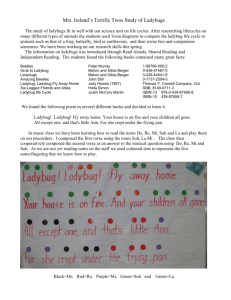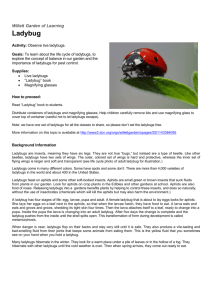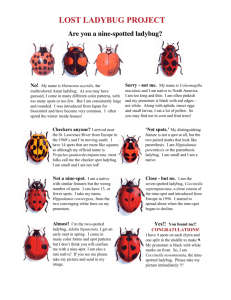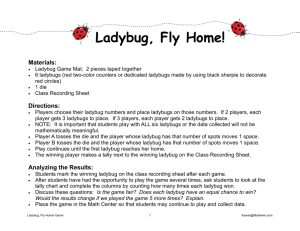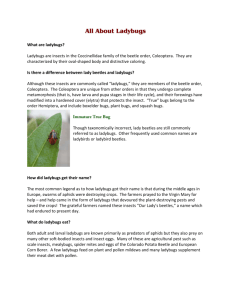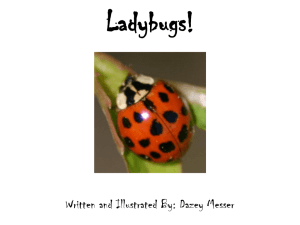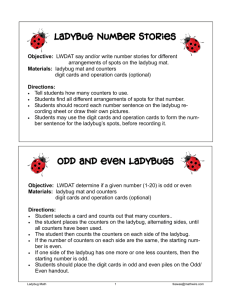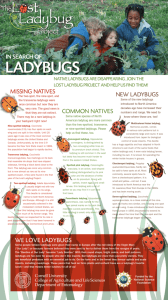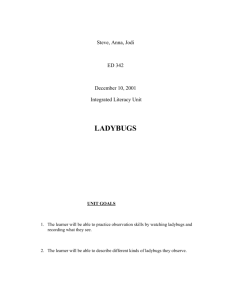Ladybug Lore
advertisement
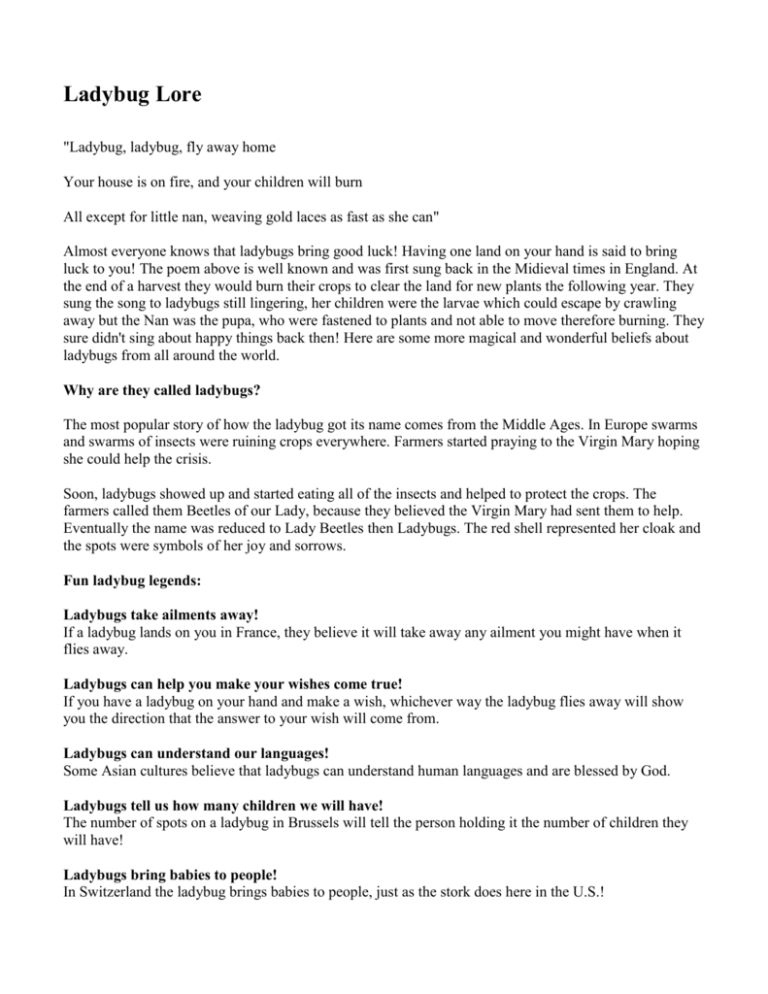
Ladybug Lore
"Ladybug, ladybug, fly away home
Your house is on fire, and your children will burn
All except for little nan, weaving gold laces as fast as she can"
Almost everyone knows that ladybugs bring good luck! Having one land on your hand is said to bring
luck to you! The poem above is well known and was first sung back in the Midieval times in England. At
the end of a harvest they would burn their crops to clear the land for new plants the following year. They
sung the song to ladybugs still lingering, her children were the larvae which could escape by crawling
away but the Nan was the pupa, who were fastened to plants and not able to move therefore burning. They
sure didn't sing about happy things back then! Here are some more magical and wonderful beliefs about
ladybugs from all around the world.
Why are they called ladybugs?
The most popular story of how the ladybug got its name comes from the Middle Ages. In Europe swarms
and swarms of insects were ruining crops everywhere. Farmers started praying to the Virgin Mary hoping
she could help the crisis.
Soon, ladybugs showed up and started eating all of the insects and helped to protect the crops. The
farmers called them Beetles of our Lady, because they believed the Virgin Mary had sent them to help.
Eventually the name was reduced to Lady Beetles then Ladybugs. The red shell represented her cloak and
the spots were symbols of her joy and sorrows.
Fun ladybug legends:
Ladybugs take ailments away!
If a ladybug lands on you in France, they believe it will take away any ailment you might have when it
flies away.
Ladybugs can help you make your wishes come true!
If you have a ladybug on your hand and make a wish, whichever way the ladybug flies away will show
you the direction that the answer to your wish will come from.
Ladybugs can understand our languages!
Some Asian cultures believe that ladybugs can understand human languages and are blessed by God.
Ladybugs tell us how many children we will have!
The number of spots on a ladybug in Brussels will tell the person holding it the number of children they
will have!
Ladybugs bring babies to people!
In Switzerland the ladybug brings babies to people, just as the stork does here in the U.S.!
Ladybugs lead us to money!
If you find a ladybug in your house, count the spots and that will be how many dollars you will soon find!
Ladybugs cure toothaches!
A long time ago dentists would mash up ladybugs to cure a toothache. (Please don't try this at home!)
Ladybugs are good omens!
It was a good omen to find a ladybug in your cabin during the pioneer days.
Ladybugs foretell the future!
If a ladybug has more than 7 spots there will be famine, less than 7 and the harvest will be good.
Around the world ladybugs are good luck!
In every culture ladybugs are good luck! Killing or harming one will bring bad luck! So if you find one in
your house, garden or on you, consider yourself lucky! Good things are coming your way!
Make a Ladybug with Plastic Clay
Making a ladybug with plastic clay can be a fun and rewarding experience. You could make them as a
simple decoration, gift or a toy for a child.
I've had the fortunate experience of making
my ladybugs with my children which allowed
me to show them the process of creating their
own toys. This I hope builds in them a greater
appreciation of their belongings and not
always taking for granted everything that
comes out of a package.
The ladybugs I've made below were very
simple to create and require just a few simple
inexpensive materials.
Materials for Making the Ladybug
I used two pre-colored blocks of plastic clay; red and black Sculpy. I also used a fine tipped pen to poke
holes for the eyes and mouth. You can get Sculpy in a variety of colors inexpensively including plain
white if you choose to paint your lady bug at {someplace}. If you do want to paint it, I recommend using
acrylics which {someplace} also has cheap.
Sculpting the Ladybug
Step: 1
Start by rolling a ball of red Sculpy for the basic shape of the ladybug's shell.
Step: 2
Create the basic shapes for 6 legs ( 3 cylinders) , 6 spots, a head, and a back stripe using black plastic
clay.
Step: 3
Assemble these pieces together to create the ladybug.
Step: 4
Carefully poke holes in the head for eyes and the mouth with a fine tip pen.
Step: 5
Place the ladybug on a cookie sheet covered with a little bit of foil and bake at 275 degrees for about 15
minute per half inch. My little ladybug took only about 25 minutes to be cooked thoroughly. Make sure to
cool thoroughly before attempting to handle the ladybug.
